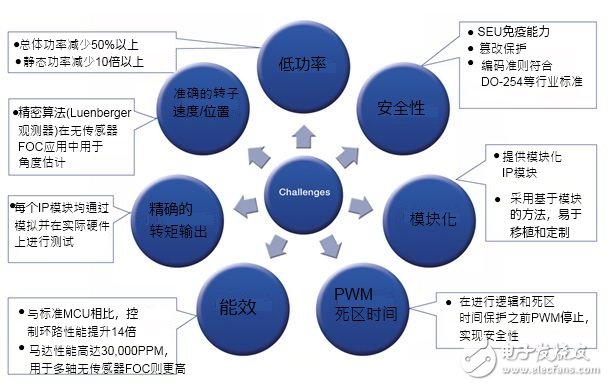For safety-critical applications, the lack of certainty due to interruptions and associated service routines is not satisfactory with the use of a microcontroller to achieve motor control.
In addition, microcontroller-based implementations cannot handle more than one motor, severely limiting their ability to achieve high performance (tensorane RPM at sampling times less than 10μs and switching frequencies above 100kHz). Figure 1 summarizes most of the challenges faced by today's motor control engineers using microcontrollers and the value that SmartFusion2 SoC FPGAs-based solutions bring to design engineers.

With the Microsemitech SmartFusion2 SoC FPGA, users can choose from a variety of alternatives:
1. Software-only solution with strict interrupt mask control
2. Partitioned hardware and software solutions for handling critical parts of motor control algorithms
3. A pure hardware solution that ensures faster speed and deterministic implementation
All of these options are adjustable to control single or multiple (up to six) motors, using multiple algorithms in very small density and small footprint devices. Algorithms that can be used today include: sensorless FOC for PMSM/BLDC, FOC using Hall, FOC with encoder, VFD for induction motor.
For pure hardware implementations, users can get a complete IP module portfolio through Libero SoC, covering Clarke and Inverse Clarke, Park and Inverse Park, and advanced PI controllers. In addition, rotor position GUI control is provided for motor configuration to achieve a single motor 30KRPM, or six motors are configured to operate in parallel in a single device using a time division multiplexing algorithm. The GUI also displays real-time signals from FPGA devices, which is very useful for debugging.
In summary, Microsemi's rugged SoC SmartFusion2 and Igloo2 FPGA devices offer greater density, allowing designers to incorporate motor control implementations and additional features in ASSPs, CPLDs, or other discrete devices. This high level of integration further saves BoM costs, reduces board space, increases overall system reliability, and simplifies the procurement process.

Text in the picture: speed reference, PI-speed controller, PI-Iq controller, IPark transition, SVPWM, PWM unit, inverter Vdc, speed action, speed calculation, PI-Id controller, angle estimation, Park transition, Clarke transition, current measurement
EN: AC220-240V/50Hz, 1000W/2000W Heat setting
US: AC120V/60Hz, 750W/1500W Heat setting
LED lights
one door open
Adjustable flame brightness
Remote control for choice(on/off,heating 1 and heating2)
The origin of the fireplace can be traced back to the time when mankind has just moved into the cave when using the "fire pond" lighting, heating, barbecue food. With the development of productive forces, lighting, heating, barbecue food these three functions gradually evolved and separated.
Fireplaces become dedicated heating equipment: the development of the times, to the fireplace has brought new changes. Morphologically speaking, the fireplace from the traditional firewood fireplace, gas fireplace, charcoal fireplace, etc., and then derived a new category: electric fireplace.
Electric fireplace is a reference to the European classical fireplace production process and modern acoustics principle, so that the traditional fireplace in the design has been greatly improved, in the elegant yet created a green and more bruised real wood burning effect.
Electric Fireplace
Electric Fireplace, European Style Electric Fireplace, LED Fake Flame Electric Fireplace, Wall Mounted Electric Fireplaces
Ningbo APG Machine(appliance)Co.,Ltd , http://www.apgelectrical.com